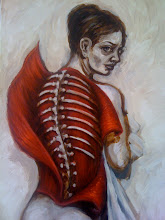The depraved behavior of delinquent, adolescent girls has been a cultural fascination for years. From Freud’s studies of the female malady to Nikki Reed‘s film depiction of teenage girls in the movie Thirteen. Behavior reported to be so debase it has become an integral part of our cultural mythos. Susan Minot’s “Lust” is a startling, real life example of wanton behavior in teenage girls. What disturbs me most in reading “Lust” is not its protagonist’s actions but their reflection of a pervasive cultural phenomenon; that is the propensity of young women victimizing themselves to their own emotional impulses.
In the instance of Minot’s protagonist, she victimizes herself to her our sexual impulses. In essence victimizing herself to her male counter parts. In the early part of the twentieth century this must have been rooted in women’s dependence on men. What is strange to me is that we see an insurgence in this kind of behavior from women directly after their emancipation. No longer politically forced to depend on men, girls continue to perpetuate emotional dependence on members of the opposite sex. Evaluating one another on what is in essence the possession of a mate.
Throughout “Lust” there is continued reference to peer pressure. Minot provides this paragraph, which is given in the first person (as is the rest of the story), as though in explanation of her actions. "I thought the worst thing anyone could call you was a cock-teaser. So, if you flirted, you had to be prepared to go through with it. Sleeping with someone was perfectly normal once you had done it (285)."
This is an excellent example of an antiquated way of thinking, which sadly persists among young girls in our culture to this day. It distresses me to see girls in the twenty-first century who perpetuate this form of self-victimization. Minot’s protagonist constantly employs words like “lust” and “sex” but continuously refuses to take responsibility for herself as a sexual being throughout the narrative.
Consciously or subconsciously she victimizes herself to her own desires. It is apparent in her narrative that the protagonist instigates relations with men, then in the aftermath feels somehow cheated, yet she refuses to initiate change on her own behalf, continuing to play victim to her repetitive behavior.
You do everything they want. "Then comes after. After when they don’t look at you. They scratch their balls, stare at the ceiling… You’re gone. Their blank look tells you that the girl they were fucking is not there anymore. You seem to have disappeared (288)."
With this paragraph Minot closes her story of debauchery. There is something unsettling about these last few sentences. The paragraph concludes the narrative seemingly without resolution, leaving the reader to assume the protagonist’s resignation to her continual self-victimization.
Though “Lust” was published in 1984 Minot’s story underlines the alarming behavior of young girls to this day. “Lust” acts almost as a window into the minds of many adolescent girls, as we follow Minot from her first sexual experience to her own feelings of dissatisfaction and debasement.
What should be viewed as alarming is not the actions of girls of Minot’s generation, or the generation of girls entering their adolescence today, but that Minot’s generation in the aftermath of their reckless youth and the psychological ramifications thereof, become the mothers of the girls now entering their adolescence today. These girls will continue to perpetuate their victimization to their own sexual impulses upon one another, to what greater social ramifications are uncertain.
Monday, November 27, 2006
Subscribe to:
Post Comments (Atom)

No comments:
Post a Comment